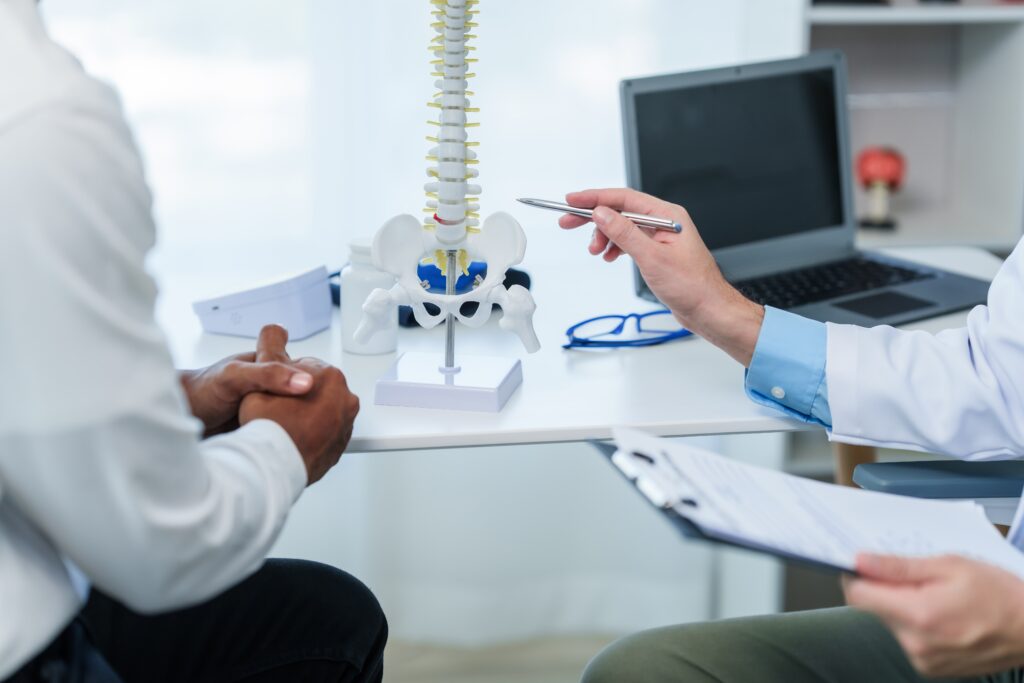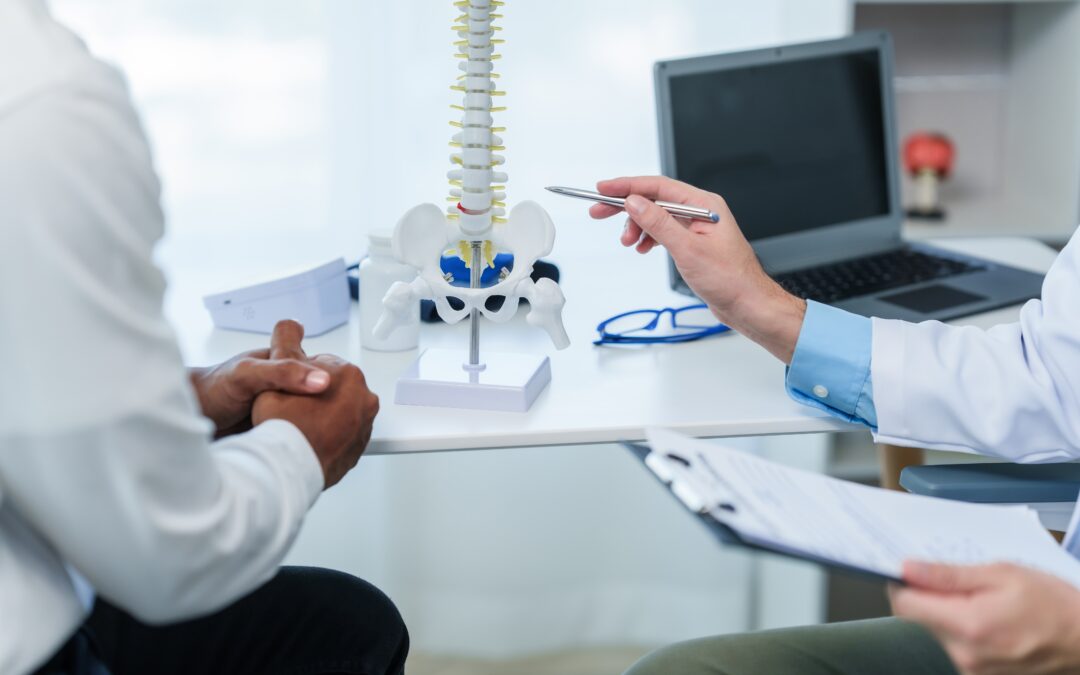 There are 33 individual bones, 40 muscles, three major ligaments, and 31 pairs of nerves in your back alone, and any number of other organs and systems in the body that contribute to the overall health of your spine and back. Even the smallest injury or abnormality can cause back pain and severely hinder your ability to live your life. And back pain is extremely common – according to the CDC, back pain is among the most common sources of discomfort for Americans, with one study indicating that 39% of patients have experienced back pain in the previous three months. (1)
There are 33 individual bones, 40 muscles, three major ligaments, and 31 pairs of nerves in your back alone, and any number of other organs and systems in the body that contribute to the overall health of your spine and back. Even the smallest injury or abnormality can cause back pain and severely hinder your ability to live your life. And back pain is extremely common – according to the CDC, back pain is among the most common sources of discomfort for Americans, with one study indicating that 39% of patients have experienced back pain in the previous three months. (1)
With the myriad of puzzle pieces that make up your back, there are a multitude of reasons you could be experiencing discomfort. We wanted to offer an overview of some of the most common conditions, as well as treatment options.
Lumbar Sprain and Strain
Soft tissue injuries – such as a sprain, which is a stretching or tearing of a ligament, or a strain, which is an injury to a muscle or tendon – are common throughout the body. They are usually caused by an injury incurred while playing sports or exercising, but can also be caused by simple everyday activities, such as a fall or abnormal twist to the back, or overuse. Patients suffering from a sprain or strain usually complain of pain at the site where the condition occurs.
Treatment: Like most soft tissue injuries, the best treatment is often the RICE (rest, ice, compression, and elevation) method. Even with this care, soft tissue injuries can take weeks or months to fully heal. Surgery is rarely needed and only in the event of a significant tear.
Lumbar Disc Herniation
Disc herniation, also referred to as a bulging, protruding, or ruptured disc, can occur anywhere along the spine, but it happens most often in the lower back, or the lumbar spine. Spinal discs contain a jelly-like nucleus that pushes against its outer ring because of injury or age-related wear and tear of the discs. If the nucleus breaks through the disc’s outer ring, it can cause pressure on the spinal cord and local nerve roots, causing irritation. Lumbar disc herniation is one of the most common causes of lower back pain, and can also lead to leg or sciatic pain, numbness or tingling in the leg or foot, and loss of bladder or bowel control. The risk factors for herniated discs include:
- Biological sex (men between the ages of 20 and 50 are more at risk)
- Being overweight
- Improper lifting
- Living a sedentary lifestyle or sitting for long periods of time
- Repetitive activities
- Smoking
Treatment: Most physicians will recommend a conservative approach to begin treatment, which includes rest, nonsteroidal anti-inflammatory drugs (NSAIDs), physical therapy, and/or steroid injections. A small percentage of patients experience muscle weakness, difficulty walking, and a significant loss of bladder or bowel control and do require surgery. Surgery can usually include endoscopic disc surgery, a minimally invasive procedure where a surgeon places an endoscope in your back to remove portions of the disc without cutting muscle or bone, or lumbar disc replacement.
Cervical Disc Herniation
Cervical disc herniation is like lumbar disc herniation, but it occurs in the upper cervical spine, and causes severe neck and arm pain. It also carries similar risk factors.
Treatment: Also, as with lumbar disc herniation, physicians will likely advocate for conservative care as the first approach to treatment – including rest, NSAIDs, physical therapy, and/or steroid injections. Surgical options include endoscopic disc surgery, anterior cervical discectomy, and cervical disc replacement.
Degenerative Spondylolisthesis
Degenerative spondylolisthesis is a condition where one vertebra slips over the vertebrae beneath it, causing low back and leg pain as well as spinal canal stenosis, the narrowing of the spinal canal in your lower back. Patients may also experience instability, pain in the buttocks and legs, and numbness, tingling, and weakness in the legs. It is usually caused by degeneration in the spine and is most common in patients over the age of 50. It is more common in women than men.
Treatment: This condition may resolve itself with rest and time, but about a third of cases progress and require surgery. (2) Surgical options include decompression surgery and spinal fusion in rare cases.
Lumbar Degenerative Disc Disease
As with all parts of your body, the discs in your spine age and degenerate. However, they degenerate at a faster rate than other systems of your body. Patients with lumbar degenerative disc disease experience lower back pain that comes and goes, can last anywhere from weeks to months, and worsens with sitting, bending, or lifting. It can also cause tingling or numbness in your arms or legs and pain that radiates down your buttocks and lower back. The risk factors include:
- Biological sex (women are more likely to experience symptoms)
- Obesity
- Smoking
- Acute injuries
- Working a physically demanding job
Treatment: Conservative treatment options include physical therapy, a regiment of NSAIDs, muscle relaxers, or steroids, steroid injections, and radiofrequency neurotomy which utilizes electric currents to cauterize nerves and prevent pain signals from reaching your brain. The most common surgical approach is discectomy, where part of a spinal disc is removed to relieve pressure on your nerves.
Thoracic Spine Fractures
Thoracic spine fractures are fractures that occur in the midback, or the thoracic spine, which is the most common part of the spine to fracture. They are usually caused by traumatic events like falling from a high height, a vehicle or motorcycle accident, sports accident, or violence. They can also be caused by bone insufficiency related to tumors, osteoporosis, or other underlying conditions. Thoracic spine fractures cause moderate to severe back pain that increases with movement. Patients may also experience numbness, tingling, or weakness in their limbs as well as bladder/bowel dysfunction.
Treatment: Due to the nature of how the fracture occurs, treatment usually must occur in conjunction with those for related injuries. Conservative treatment includes bracing, physical therapy, and pain management. Decompression or stabilization surgery may be necessary depending on the quality and quantity of the fractures.
Symptomatic Osteoporotic Spinal Compression Fractures
Symptomatic osteoporotic spinal compression fractures are caused by low bone mineral density, making the bones weak and more susceptible to fracture. They occur most often in postmenopausal women and patients taking long-term corticosteroid therapy. Risk factors also include low body weight and recent weight loss. Symptomatic osteoporotic spinal compression fractures cause moderate to severe back pain.
Treatment: Treatments for symptomatic osteoporotic spinal compression fractures include bracing, physical therapy, and pain management. Surgical options are limited due to complications from low bone density, but patients have shown success with kyphoplasty, a minimally invasive procedure that restores bone height with an inflated balloon and uses bone cement to support bone stability.
Multiple Myeloma of the Spine
Multiple myeloma, also known as myeloma, is the most common type of primary bone cancer. Myeloma cancer cells attack a patient’s bone marrow, causing the bones to appear to have holes when viewed through imaging. It occurs most frequently in older adults, as well as more commonly in men than women and African Americans than Caucasians. Patients experience bone pain, fatigue, fever, night sweats, weight loss, and overall poor health.
Treatment: The treatment of myeloma is similar to the treatment for most cancers, including chemotherapy, radiation, and gene therapy. Surgery may be needed if the weakness in the bone causes fractures too severe to heal with conservative treatments.
At Englewood Spine Associates, we have over 25 years of experience in providing spinal care and surgery. Our goal is to help you feel better so that you can get back to living with less pain, and we strive to treat our patients with the most conservative approach possible. But when conservative care fails, we have many state-of-the-art, minimally invasive solutions that can be tailored to treating your condition. We have the expertise and resources to treat your back condition – no matter how severe. Please contact us today for a consultation.



Recent Comments